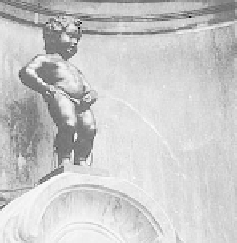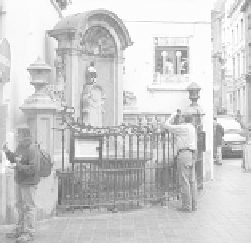Travel Reference
In-Depth Information
Tapestries
In 1500, tapestry workshops in Brussels were famous, crank-
ing out high-quality tapestries for the walls of Europe's pal-
aces. They were functional (as insulation and propaganda
for a church, king, or nobleman) and beautiful—an intricate
design formed by colored thread. Even great painters (such
as Rubens and Raphael) designed tapestries, which rivaled
Renaissance canvases.
First, neutral-colored threads (made from imported
English wool) are stretched vertically over a loom. The design
of the tapestry is created with the horizontal weave, from the
colored threads that (mostly) overlay the vertical threads.
Tapestry-making is much more difficult than basic weaving
because each horizontal thread is only as long as the detail
it's meant to create, so a single horizontal row can be made
up of many individual pieces of thread. The weavers follow a
pattern designed by an artist, called a “cartoon.”
Flanders and Paris (the Gobelins workshop) were the
two centers of tapestry-making until the art died out, along
with Europe's noble class.
Manneken-Pis
Even with low expectations, this bronze statue is smaller than
you'd think—the little squirt's under
two feet tall, practically the size of a
newborn. Still, the little peeing boy is
an appropriately low-key symbol for the
unpretentious Bruxelloise. The statue
was made in 1619 to provide drinking
water for the neighborhood. Sometimes,
Manneken-Pis
is dressed in one of the
700 different costumes that visiting VIPs
have brought for him (including an Elvis
Pissley outfit).
There are several different legends about
Manneken
—take
your pick. He was a naughty boy
who peed inside a witch's house,
so she froze him. A rich man
lost his son and declared, “Find
my son, and we'll make a statue
of him doing what he did when
found.” Or—the locals' favorite
version—the little tyke loved his
beer, which came in handy when
a f ire threatened the wooden
city: He bravely put it out. Want




















